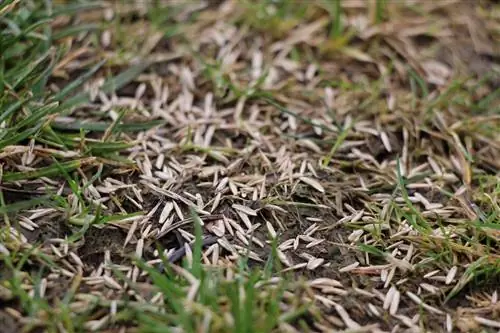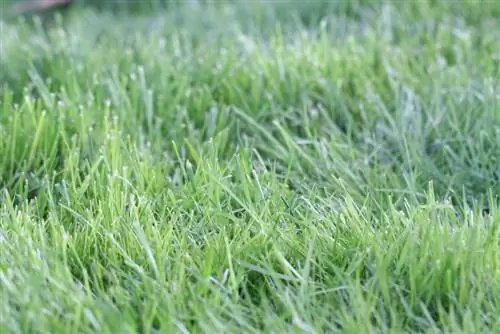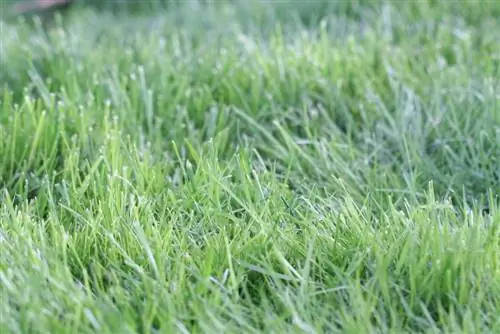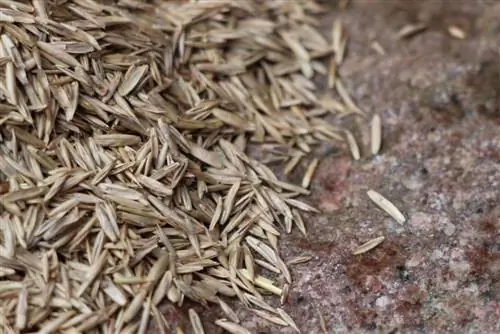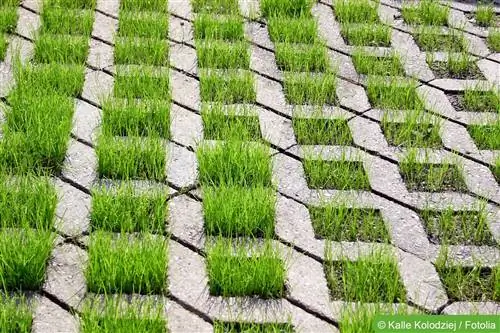- Author admin [email protected].
- Public 2023-12-17 03:39.
- Last modified 2025-01-24 12:45.
You can also use the time of September and October to carry out repair work so that your lawn looks even more beautiful next spring:
Good time for reseeding
If your lawn would benefit from growth, you should use the autumn to re-seed. Partial reseeding should become an annual habit for every lawn owner once the lawn is a few years old. Because the lawn grasses are perennial, so they die after a few years. In addition, a lawn can of course suffer drought damage during a hot summer, sometimes even causing larger gaps.
Autumn is an excellent time for reseeding because the grass can then germinate and then has a long rest period in which the roots can develop and strengthen. However, you must give the new seeds the chance to develop sufficiently until winter. It is therefore best to reseed immediately when the heat wave is over. As a rule, re-sowing can be carried out around the beginning of September.
If you want to overseed, you should either use a special overseeding mix for the bare spots or take the opportunity to change the composition of your lawn. This is useful if you are dealing with lawn plants that don't actually correspond exactly to the use they are actually exposed to. Then you could use a regular seed mixture for overseeding, which guarantees that the lawn that sprouts from the overseeding will have exactly the properties that you require from your lawn.
As a tested standard seed mixture (RSM), you can purchase special seeds for utility lawns, hard-wearing lawns or ornamental lawns, each with several subspecies. If you have other wishes for your lawn: There are a few other varieties. If the existing lawn has only a few gaps, you would need to inquire about the varieties that are suitable for reseeding under these conditions - not every lawn seed grows well in densely rooted areas.
Prepare reseeding and sow correctly
In any case, the soil must be prepared for reseeding so that the seeds come into good contact with the soil. It should be lightly covered. Lawn seeds do not need any light to germinate and are then protected from drought and bird damage. You should not simply throw the seeds onto the turf, but rather scratch the soil lightly beforehand and only then scatter the seeds. The best way to do this is to scarify beforehand, so that the unnecessary old material is removed straight away. If you then mow the lawn very short, the existing lawn will be weakened in its competitiveness, so that reseeding has a good chance (plus the remains from scarifying are picked up straight away).
However, if you overseed a different type of lawn, be prepared for your lawn to look slightly “patchy” because the overseeding produces grasses of a different color. If you can improve the quality of the lawn by doing this, it's best to just accept it, after mowing it will hardly be noticeable and after the next re-seeding of your "dream seed mixture" it probably won't be noticeable at all.
There are also “spots” when sowing special reseeding mixtures, and in the experience of many lawn owners, even to a greater extent, because these reseeding mixtures, regardless of their other suitability, primarily contain varieties that germinate and grow particularly quickly.
Other lawn care in September and October
If the lawn has not yet received its autumn fertilization in August, you should apply a potassium-based final fertilization in October. If your lawn now gets a lot of potassium, it will be well equipped to withstand the cold and dryness in winter, and it will also be able to resist fungal infestation.
As soon as the leaves start to fall, the leaves should definitely be removed from the lawn. The lawn doesn't like being smothered and shaded under the foliage at all. With the piles of leaves on the lawn, the risk of fungi settling, which love the climate under the leaves, also increases. It is usually enough to pick up the leaves when mowing the lawn, but you should only use a rake occasionally if you have a lot of trees in the garden.
You can use the raked leaves for mulching, i.e. spread them under the trees as natural fertilizer. You can of course also compost them. If there is no compost heap, you will be doing small mammals and insects a favor by piling up the leaves in a corner of the garden - they will happily overwinter in the heap.
When the final cut is due depends on growth and weather. In any case, you will have to mow until the end of October. The cut can be a little shorter than in midsummer (cut with the highest lawn height) because shading is no longer needed (on the contrary, your lawn now needs all the light it can get). The last cut of the year can also be much later. If the weather is pleasant, your lawn will continue to grow well into winter, especially in warmer climates.
When it comes to watering, you shouldn't say goodbye to the winter break too early: September is one of the driest months for the lawn, and even later in the year it can get so dry that the lawn loses water Sprenger needs.
More tips
- Now is also the time to give your lawn mower a little attention before it goes into winter break. The spark plug connector on the motor mower should be removed before any maintenance work is carried out. Then you can work without the engine starting. You should thoroughly remove all deposits from the housing, the blade and the wheels, then the mower is lubricated inside and out, the metal parts are good with a treatment with rust inhibitor.
- Polish fertilization was already recommended above. Under no circumstances should you apply your usual long-term lawn fertilizer in autumn, as this would really stimulate the growth of the lawn, but this is not beneficial: the lawn would go into the winter with soft, thin grasses that are very susceptible to frost and… Diseases would be.
- When you mow now, you should not leave the lawn lower or higher than the normal lawn height recommended. Cut very short, leaving the soil just a little more exposed to frost, which can now penetrate the root area more easily. If you let the lawn stand higher, frozen grass may tip over, which would then cause the grass growing underneath to die, and the lawn would then have gaps in the spring. Rather, the lawn should start the winter at exactly the same height as it was during the season.

